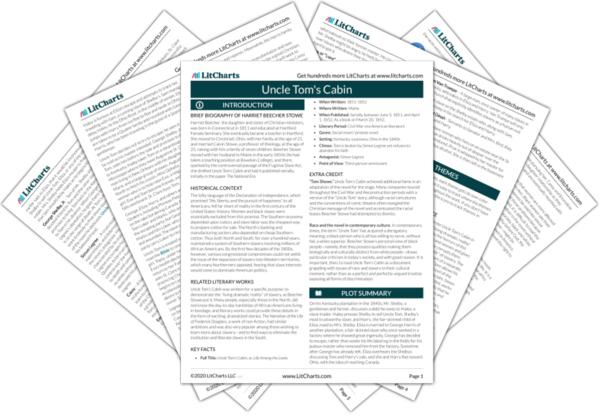Welcome to the LitCharts study guide on Harriet Beecher Stowe's Uncle Tom's Cabin. Created by the original team behind SparkNotes, LitCharts are the world's best literature guides.
Uncle Tom's Cabin: Introduction
Uncle Tom's Cabin: Plot Summary
Uncle Tom's Cabin: Detailed Summary & Analysis
Uncle Tom's Cabin: Themes
Uncle Tom's Cabin: Quotes
Uncle Tom's Cabin: Characters
Uncle Tom's Cabin: Symbols
Uncle Tom's Cabin: Literary Devices
Uncle Tom's Cabin: Theme Wheel
Brief Biography of Harriet Beecher Stowe

Historical Context of Uncle Tom's Cabin
Other Books Related to Uncle Tom's Cabin
- Full Title: Uncle Tom’s Cabin, or, Life Among the Lowly
- When Written: 1851-1852
- Where Written: Maine
- When Published: Serially, between June 5, 1851, and April 1, 1852. As a book on March 20, 1852.
- Literary Period: Civil War-era American literature
- Genre: Social novel / protest novel
- Setting: Kentucky, Louisiana, Ohio in the 1840s
- Climax: Tom is beaten by Simon Legree yet refuses to abandon his faith
- Antagonist: Simon Legree
- Point of View: Third-person omniscient
Extra Credit for Uncle Tom's Cabin
“Tom Shows.” Uncle Tom’s Cabin achieved additional fame in an adaptation of the novel for the stage. Many companies toured throughout the Civil War and Reconstruction periods with a version of the “Uncle Tom” story, although racial caricatures and the conventions of comic theatre often mangled the Christian message of the novel and accentuated the racial biases Beecher Stowe had attempted to dismiss.
Race and the novel in contemporary culture. In contemporary times, the term “Uncle Tom” has acquired a derogatory meaning: a black person who is all too willing to serve, without fail, a white superior. Beecher Stowe’s personal view of black people—namely, that they possess qualities making them biologically and culturally distinct from white people—draws particular criticism in today’s society, and with good reason. It is important, then, to read Uncle Tom’s Cabin as a document grappling with issues of race and slavery in their cultural moment, rather than as a perfect and perfectly-argued treatise exposing all forms of discrimination.












